

Celestia. Mars Odyssey Mission THEMIS. 10 Years on the ISS. Space News. Malin Space Science Systems. Astronomy Picture of the Day. Discover the cosmos!

Each day a different image or photograph of our fascinating universe is featured, along with a brief explanation written by a professional astronomer. 2016 April 15 Mercury and Crescent Moon Set Image Credit & Copyright: Miguel Claro (TWAN, Dark Sky Alqueva) Explanation: Innermost planet Mercury and a thin crescent Moon are never found far from the Sun in planet Earth's skies. Home. Newly Discovered Molecule Will Make Rocket Fuel Super Efficient. Solar System Visualizer. High Resolution Imaging Science Experiment.
Image of the the Day - Gallery. NASA Goddard Scientific Visualization Studio. Mars Reconnaissance Orbiter. Stellarium. Software. Mars Odyssey Mission THEMIS. Quiet american. Astronomy. Mars Exploration Program. NASA Science. The Moon. HRSC image viewer. Nasa. NASA. Literature & Poetry Sites. The Telescope - Nuts & Bolts. Images. WebStars: Astrophysics in Cyberspace. This list of astronomical resource sites is intended as a resource for users who have a general interest in astronomical topics.
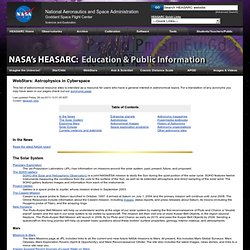
For a translation of any acronyms you may have seen in our pages check out our acronyms page. Team Hubble - Servicing Missions: Visualization Explorer for the iPad - Home. The NASA Visualization Explorer features visualizations, animations and images of our sun and the universe.
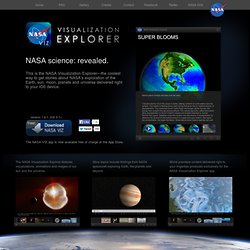
Story topics include findings from NASA spacecraft exploring Earth, the planets and beyond. Blog Central - Premiering Tonight: "First Orbit" Shows Yuri Gagarin's 1961 View From Space. Top 100 - NASA / ESA Hubble space telescope [en] The Sun. Advanced Search. Image of the Day. Planets. Space the final frontier (learn more about space and technology) Gallery. News & Blogs. Antarctic Ice. Myexploration. Unmanned Spaceflight.com (Powered by Invision Power Board) NASA spacecraft due for rendezvous with comet Tempel 1. It's not exactly young love, but some might find it romantic.
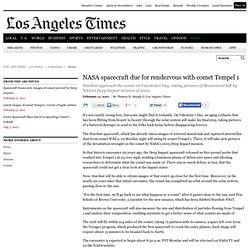
On Valentine's Day, an aging Lothario that has been flitting from beauty to beauty through the solar system will make his final stop, taking pictures of a battered dowager to send to the folks back home before disappearing forever. The Stardust spacecraft, which has already taken images of asteroid Annefrank and captured interstellar dust from comet Wild 2, on Monday night will swing by comet Tempel 1. There, it will take new pictures of the devastation wrought on the comet by NASA's 2005 Deep Impact mission. In that historic encounter six years ago, the Deep Impact spacecraft released an 820-pound probe that crashed into Tempel 1 at 23,000 mph, sending a luminous plume of debris into space and allowing researchers to determine what the comet was made of.
There was so much debris, in fact, that the spacecraft could not get a clear look at the impact crater. The encounter is expected to begin about 8:30 p.m. Teidesky_casado_3000. Space Engine – Free Universe Simulator. Weekend Feature: NASA-ESA Announce Europa Mission -Search for Life on Jupiter's Water Worlds. Patrice Lamothe. WFCAM Science Archive. UKIDSS Galactic Plane Survey (GPS) Mosaic - DR7 The main window below displays a 6 billion pixel (1 arcsec pixels) mosaic of the GPS (centre: l=52, b=0 (109 > l > 0 ,360 > l > 355 and -2.5 < b < +2.5).
Use the controls in the main window or the mouse (click&drag ) to move around the image and zoom in and out. Click on the small images on the left to move to that point in the mosaic. Other versions: dr6 release dr4 release dr3 release dr2 release. Latest Mars Weather. Captioned Image Release No.
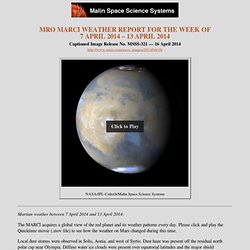
MSSS-321 — 16 April 2014 Martian weather between 7 April 2014 and 13 April 2014: The MARCI acquires a global view of the red planet and its weather patterns every day. Please click and play the Quicktime movie (.mov file) to see how the weather on Mars changed during this time. Local dust storms were observed in Solis, Aonia, and west of Syrtis. 3DV - NASA 3D Virtuality. 100 Rules of NASA. SpaceWeather. Multimedia - Video Gallery. Chromoscope - View the Universe in different wavelengths. Stellarium. Spain.
Solar System Scope. A Brief, Wondrous Tour of Earth (From Outer Space) Solar System Scope. Planetary Society. Asteroid Watch. Recent News February 5, 2015NASA's Dawn spacecraft, on approach to dwarf planet Ceres, has acquired its latest and closest-yet snapshot of this mysterious world. › Read more January 27, 2015NASA's Dawn spacecraft has returned the sharpest images ever seen of the dwarf planet Ceres. › Read more January 22, 2015There has been a significant increase in the amount of water "pouring" out of the Rosetta mission's comet. › Read more › More news Next Five Close Approaches Average distance between Earth and the moon is about 239,000 miles (385,000 kilometers).

The Asteroid Watch Widget tracks asteroids and comets that will make relatively close approaches to Earth. Universe Today. Webb Sunshield Like an Umbrella on the Shores of the Universe. Heavens-Above. Hubble's Best Photos. Wallpaper. Videos See the universe come to life via animations, scientific visualizations, expert commentary, and more.
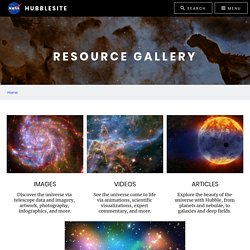
ROSAT Re-entry. ROSAT (short for Röntgensatellit, in German X-rays are called Röntgenstrahlen, in honour of Wilhelm Röntgen) is a defunct German Aerospace Center-led satellite X-ray telescope, with instruments built by Germany, the UK and the US.

It was launched on 1 June 1990, on a Delta II rocket from Cape Canaveral, on what was initially designed as an 18 month mission, with provision for up to 5 years of operation. ROSAT actually operated for over 8 years, finally shutting down on 12 February 1999. ROSAT is expected to re-enter the Earth's atmosphere between October 21 and 23 2011. In February 2011, it was reported that the 2,400 kg satellite was unlikely to burn up entirely while re-entering the earth atmosphere due to the large amount of ceramics and glass used in construction.
HubbleSite. The Telescope - Team Hubble. Goddard Space Flight Center is home to the Space Telescope Operations Control Center for Hubble.

Gathering images from space is more than a "point and shoot" proposition. The Hubble Space Telescope explores our universe 24 hours a day, 365 days a year.